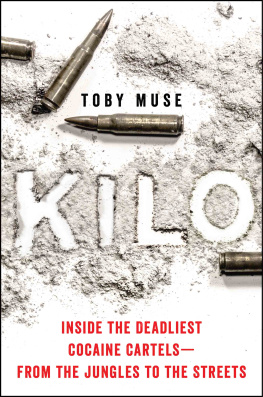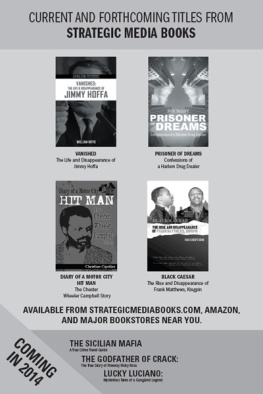Copyright 2018 by Maria McFarland Snchez-Moreno.
Hachette Book Group supports the right to free expression and the value of copyright. The purpose of copyright is to encourage writers and artists to produce the creative works that enrich our culture.
The scanning, uploading, and distribution of this book without permission is a theft of the authors intellectual property. If you would like permission to use material from the book (other than for review purposes), please contact permissions@hbgusa.com. Thank you for your support of the authors rights.
Published by Nation Books, an imprint of Perseus Books Group, LLC, a subsidiary of Hachette Book Group, Inc.
Nation Books is a co-publishing venture of the Nation Institute and Perseus Books.
The Hachette Speakers Bureau provides a wide range of authors for speaking events. To find out more, go to www.hachettespeakersbureau.com or call (866) 376-6591.
The publisher is not responsible for websites (or their content) that are not owned by the publisher.
Library of Congress Cataloging-in-Publication Data has been applied for.
The woman measured him with a pitying look.
There havent been any dead here, she said.
Since the time of your uncle, the colonel, nothing has happened in Macondo.
Gabriel Garca Mrquez,
One Hundred Years of Solitude
Their embassies, he said, were everywhere but operated independently and no ambassador would ever be relieved.
Seamus Heaney,
From the Republic of Conscience,
The Haw Lantern
P ROLOGUE:
L AND OF S MOKE AND M IRRORS
I F THIS COUNTRY KNEW THE whole truth, it would fall apart, Rodrigo Zapata announces, smirking at me. We are uncomfortably perched on a couple of battered plastic chairs next to a grimy desk in the stifling visitors room in Itag prison, on the outskirts of the Colombian city of Medelln. This is the very same city that, while in the grip of cocaine kingpin Pablo Escobar more than two decades earlier, was known as the murder capital of the world, on account of its astronomical rate of killings. When we meet, it is June 2014, and news coverage of Medelln is more likely to fawn over the citys world-class metro and libraries than to focus on the brutal realities on which its gleaming infrastructure rests. But if anyone knows about those realities, its Zapata.
A soft, large man in his forties, in new sneakers, jeans, and a fresh blue-and-white-checked shirt on which he has affixed a small pin with the image of a Catholic saint, Zapata looks nothing like what youd expect in a hardened criminal charged with multiple murders. A former senior member of the countrys vicious cocaine-running paramilitary groups, Zapata had worked for one of their top commanders, Vicente Castaoa man said to be so cold-hearted that he had his own brother assassinated.
Starting in the late 1990s, the paramilitaries carried out a bloody expansion campaign throughout much of Colombia. Fueled by an endless stream of drug profits, they committed gruesome massacres in the name of defending the country from the brutal Marxist guerrillas of the Revolutionary Armed Forces of Colombia, or FARC (Fuerzas Armadas Revolucionarias de Colombia). They killed trade unionists, human rights activists, journalists, schoolteachers, and judges. They gouged out the eyes of their victims, tore off their limbs, and raped them in front of their families.
Nobody, it seemed, was trying to stop them: vast sectors of the government and military secretly supported them. The United States, more interested in the appearance of success in its war on drugs than in stopping the carnage in a country that few in the United States understood, largely ignored them even as it poured billions of dollars into Colombias military. Those who did dare to stand up to the paramilitaries almost always ended up dead.
Swatting at the gnats hovering around us, Zapata tells me that he was mainly a financial adviser to Castao, helping him with acquisitions for his farms and handling some of the groups political work, though he doesnt really explain what that means. He would later be convicted of leading a paramilitary unit operating along the Pacific coast of Colombiaone of the nations poorest areas. The paramilitary onslaught in the region had forced thousands of Afro-Colombians and indigenous persons along the coast to flee their farms; in several cases, their land ended up fraudulently registered in the name of the paramilitaries cronies. Even though the groups have supposedly disarmed, many of the original owners are still too terrified to return.
But things are starting to change. Over the past few years, some of the truth about the paramilitaries relationships with senior members of Colombias military forces and government has started to trickle out. My sources have described Zapata as a key player in handling those relationships. So Im hoping that he will tell me more than what is already publicly known.
He doesnt. Sitting in front of me, Zapata is friendly, chatty, and far from frightening. He speaks with a childs glee at a new toy, and through his grin I catch a glimpse of tiny front teeth. Combined with his saucer-shaped eyes, they give him an almost cartoonish appearance, like an oversized toddler or teddy bear. Could this guy really be as bad as people say?
But few things in Colombia are what they appear to be.
T HE FIRST TIME I traveled to Bogot, Colombias mountainous capital, a hailstorm hit the city. It was November 2004, and as my colleagues and I weaved our way through traffic from the airport to our hotel, clumps of ice the size of golf balls pounded the cars windshield. A gray haze enveloped us, obscuring the mix of run-down old homes, modern red brick buildings, and tall mountains that give the city its contours.
The hail surprised me. Having grown up in neighboring Peru in the 1980s and early 1990s, I thought I would be able to predict certain things about Colombia, including the weather. Rain was common in the mountain cities that I knew in Peru, but I had never seen hail. It was only the first time my expectations were shattered during that and countless other visits to Colombia over the next six years, when I covered the country as an investigator for the international organization Human Rights Watch.
Like the Peru of my childhood, Colombia had for years been ravaged by a brutal internal war between left-wing guerrillas (in Colombia the most prominent were the FARC) and government forces. Even the wealthier classes in the major cities were affected by the war: it was hard for them to travel on highways or visit their country homes, because of the risk of kidnapping by the FARC. But, as in Peru, it was the countrys poorest and most vulnerableindigenous people, peasants, Afro-Colombianswho, trapped between the warring factions, bore the brunt of the violence.








